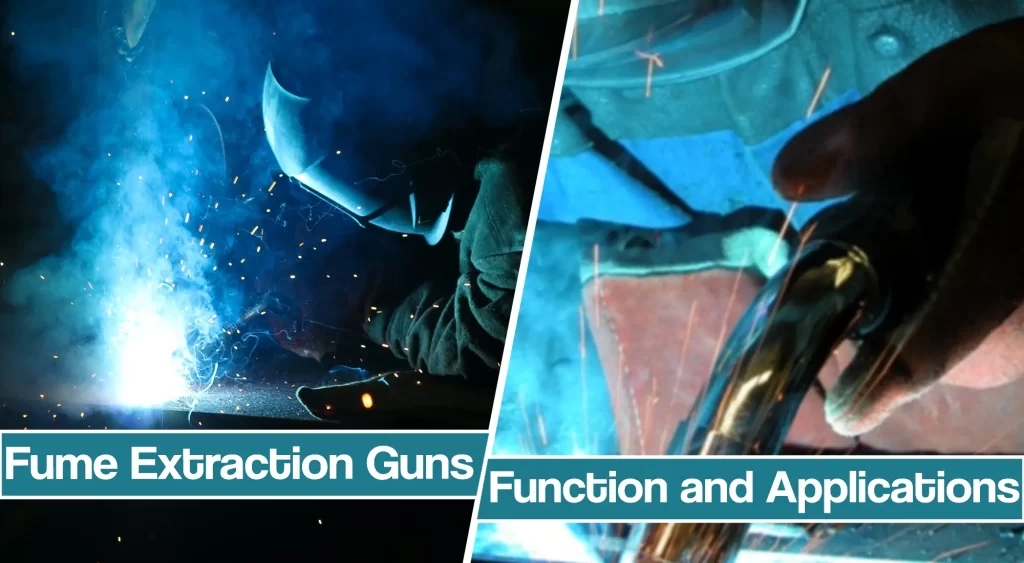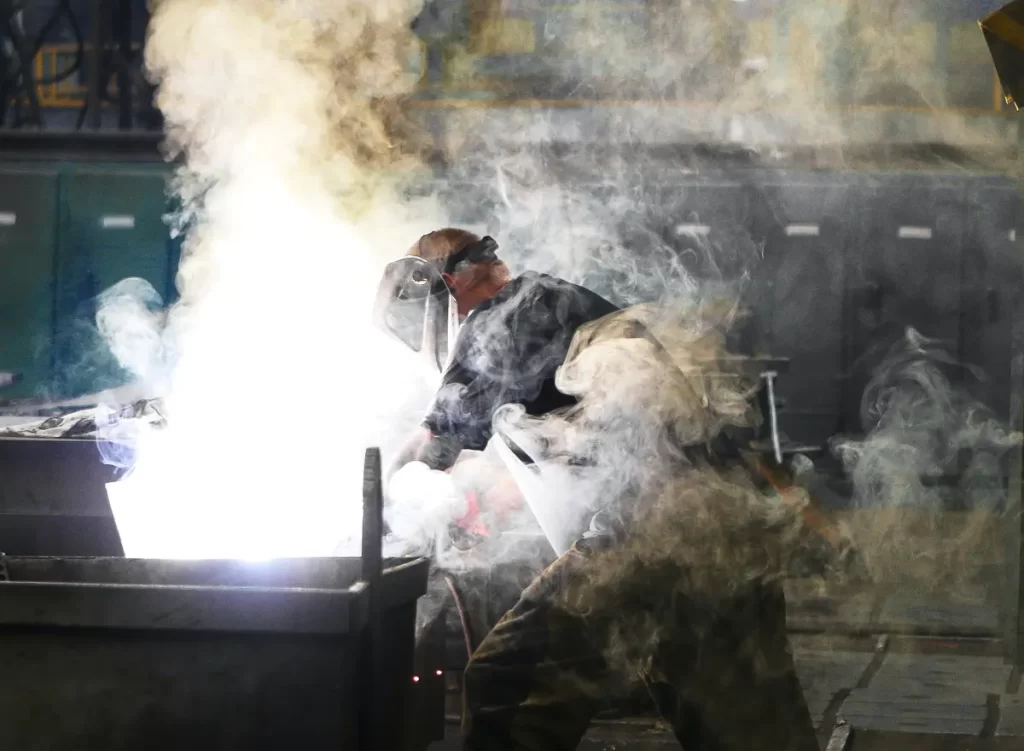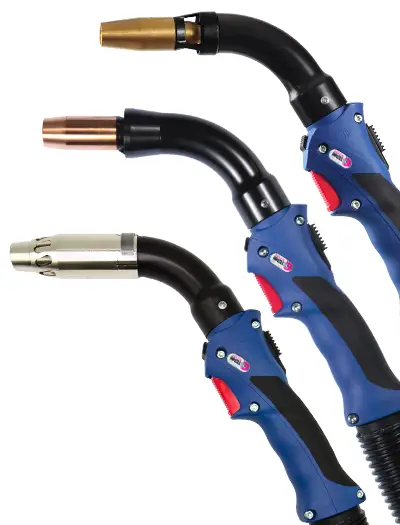Regardless of the welding process that an operation selects, maintaining the appropriate safety procedures is critical.
Besides the body, face, and eye protection, it’s necessary to protect your lungs too. Welders are constantly exposed to hazardous welding fumes that cause cancer and other serious health alignments.

In this article, you’ll learn what fume-extraction guns are, how they work, where they are applied, and how to maintain your fume-extraction gun.
Welding Fume Extraction Guns Applications
Providing welding operators with the proper ventilation during the welding process is essential, too.
Occupational Safety and Health Administration (OSHA) and other safety regulatory bodies have established standards for the levels of allowable exposure limits of welding fumes and other particulates (including hexavalent chromium.)
For some companies, using a fume-extraction gun (in conjunction with a fume-extraction device or filtration system)
is a viable option for maintaining compliance with these regulations and keeping welding operators safe and comfortable.

Fume-extraction guns are available in various amperages (typically 300 to 600), cable styles, and handle designs, and like all welding equipment, they have their best applications, advantages, and limitations. Fume-extraction guns are especially beneficial for welding in confined spaces, where the goal is to capture fumes immediately at the source —in the welding operator’s breathing zone.
Industries, where these applications occur, include heavy equipment manufacturing and shipbuilding. General manufacturing and fabrication applications with mild or carbon steel may also present the opportunity to use a fume-extraction gun, as can petrochemical operations or other applications where stainless steel welding and greater hexavalent chromium levels are likely.
The guns work well on high amperage and high deposition rate applications, too.
Some companies choose fume-extraction guns with a localized filtration system instead of a more intricate and expensive centralized fume-extraction system, which involves the installation of ductwork throughout the shop area.
Regardless of the application, it’s a good idea to modify other aspects of the welding operation (filler metals, base material, transfer methods, etc.) to help minimize fume rates. Doing so adds to the safety and comfort of the welder that, starts with a fume-extraction gun.
How Fume-Extraction Guns Work
Every fume-extraction gun manufacturer designs and produces its product to operate differently.
As a general rule, however, fume-extraction guns operate by mass flow, the movement of material initiated by a vacuum chamber in the fume-extraction gun.
The vacuum chamber suctions the fumes through the gun’s handle, into the gun’s hose through to a port on the filtration system. Sometimes these filtration systems are called vacuum boxes or fume-extraction systems.
The welding fumes that these guns remove are a combination of the filler metal and base material, and their removal by the fume-extraction gun occurs right at the source, over and around the weld pool.
As with the specific manner in which fume-extraction guns operate, features on these guns are often unique to individual manufacturers. Some fume-extraction guns feature adjustable extraction control regulators at the front of the gun handle.

These regulators allow welding operators to increase suction as needed without affecting shielding gas coverage. Other manufacturers may offer the same function, but it is internal to the gun. In both instances, the welding gun balances the shielding gas and the suctioned air.
The combination protects the weld pool from defects like porosity, while also eliminating fumes to protect the welding operator. It allows the weld pool time to react and solidify and gives the fume particles time to decelerate, making them easier to extract.
How Fume Extraction Guns Are Different From MIG and Flux-Cored Guns
In addition to offering fume-extraction capabilities, fume-extraction guns differ in other ways from their counterparts, MIG and flux-cored guns. As a general rule, fume-extraction guns are larger than these other guns. They also tend to be bulkier as a result of the vacuum and hose that are responsible for extracting the fumes.
To facilitate maneuverability, some fume-extraction guns manufacturers have found ways to engineer internal components to minimize the handle weight and/or have added a vacuum hose swivel on the rear of the handle that allows the welding operator to change angles more readily.
For fume-extraction guns to work to their greatest capacity, they should be used for in-position welding, such as on flat butt welds. In this position, these guns offer the distinct advantage of removing the fumes at the source, minimizing the amount that enters the welding operator’s immediate breathing zone.
Welding out-of-position limits the ability of the gun to suction the fumes downward and through the vacuum hose (i.e., as the fume particles are rising overhead).
Also, because welding operators typically move the gun away from the weld pool after completing a pass, the fume-extraction gun is not as able to control residual fumes. Therefore, some companies may prefer to install a fume-extraction hood, trunk-style extractor, or a centralized system.
Welding Fume-Extraction Guns Maintenance
After the selection, fume-extraction guns require preventive maintenance, like any other welding equipment. You can read more about MIG equipment maintenance here.
Consider these tips to help extend the life of the equipment and prevent downtime for addressing problems:
- 1. Frequently inspect the nozzle and contact tip for signs of spatter build-up that could obstruct shielding gas flow, create weld defects or cause the consumables to fail prematurely. Also, inspect the shroud that surrounds the nozzle. Replace these consumables or clean them according to the manufacturer’s recommendation.
- 2. Minimize electrical resistance that could cause quality issues or premature consumable failure by regularly checking for tight connections throughout the length of the fume-extraction gun. The neck, contact tip, nozzle, and diffusers should all be snug.
- 3. Inspect the vacuum hose regularly for cuts, kinks, or other damage that could lead to loss of suction. Replace a damaged vacuum hose as necessary and dispose of it according to the manufacturer’s and/or an industrial hygienist’s directions.
- 4. Periodically clean the liner with compressed air to prevent potential blockages. Welding operators can complete this task during routine pauses in production to avoid unnecessary downtime. Tracking the length of time the liner takes to wear and replacing it ahead of time is also a good idea. It can help prevent wire feeding or quality issues.
- 5. Visually inspect the handle for cracks or missing screws, and also check that the gun’s trigger is not sticking or otherwise malfunctioning. Replace or repair these components as necessary.
No matter the type of equipment an operator may choose, working with a trusted welding distributor, certified industrial hygienist, and/or the fume-extraction gun manufacturer can help address any questions or concerns, and put the operation on the right path to a safer, more comfortable welding environment.




